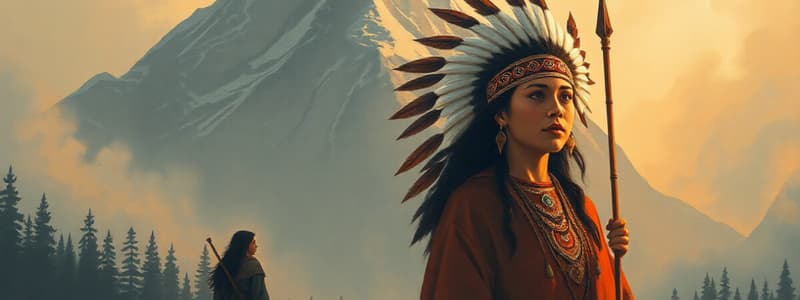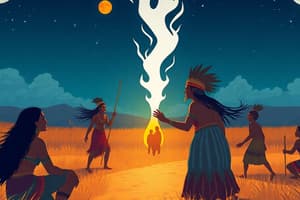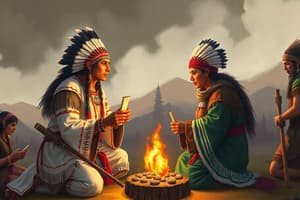Podcast
Questions and Answers
Which action was a primary goal of the Canadian government's enfranchisement policy?
Which action was a primary goal of the Canadian government's enfranchisement policy?
- To enhance Indigenous cultural practices by providing additional government funding.
- To increase the number of 'Status Indians' to expand the government's control.
- To fairly distribute land and financial resources among Indigenous communities.
- To integrate Indigenous peoples into settler society, thus diminishing distinct identities. (correct)
What was a major negative consequence of enfranchisement for Indigenous peoples?
What was a major negative consequence of enfranchisement for Indigenous peoples?
- It ensured better access to education and health services for Indigenous peoples.
- It resulted in the loss of treaty rights, including hunting, fishing, and government payments. (correct)
- It granted full ownership of reserve lands by the Indigenous peoples.
- It led to increased access to government services and programs.
What was a gain for Indigenous peoples upon enfranchisement?
What was a gain for Indigenous peoples upon enfranchisement?
- The ability to own land and vote in government elections. (correct)
- The ability to live only on reserves.
- The right to maintain status as ‘Indians’ under the law.
- Unrestricted hunting and fishing rights on any land.
Which of the following best describes the primary purpose of a vision quest?
Which of the following best describes the primary purpose of a vision quest?
What typically occurs during a vision quest, according to the text?
What typically occurs during a vision quest, according to the text?
What is the primary purpose of a Potlatch?
What is the primary purpose of a Potlatch?
Which of the following best describes a stereotype?
Which of the following best describes a stereotype?
What is the main goal of Peace and Friendship treaties?
What is the main goal of Peace and Friendship treaties?
What is ‘enfranchisement’ as it pertains to Indigenous peoples in Canada?
What is ‘enfranchisement’ as it pertains to Indigenous peoples in Canada?
What typically occurs during a potlatch ceremony?
What typically occurs during a potlatch ceremony?
Why did Veterans who were Status Indians sometimes lose their status after the Second World War?
Why did Veterans who were Status Indians sometimes lose their status after the Second World War?
In addition to demonstrating a leader's wealth and power, what else does a potlatch emphasize?
In addition to demonstrating a leader's wealth and power, what else does a potlatch emphasize?
Who signed a peace of friendship treaty with the Governor of Nova Scotia in 1752?
Who signed a peace of friendship treaty with the Governor of Nova Scotia in 1752?
What was the primary objective of Canada's 'White Paper' policy?
What was the primary objective of Canada's 'White Paper' policy?
Which document was produced by Native Leaders in response to the 'White Paper' policy?
Which document was produced by Native Leaders in response to the 'White Paper' policy?
What is the significance of oral histories to the Mi'kmaw people?
What is the significance of oral histories to the Mi'kmaw people?
What was a primary goal of the residential school system?
What was a primary goal of the residential school system?
How did Mi'kmaw people traditionally construct their wigwams?
How did Mi'kmaw people traditionally construct their wigwams?
What were the key features of birch bark when used in wigwam construction?
What were the key features of birch bark when used in wigwam construction?
Besides educating children, what was a crucial role of elders in Mi'kmaw communities?
Besides educating children, what was a crucial role of elders in Mi'kmaw communities?
What did Mi'kmaw elders provide, in addition to education and spiritual guidance?
What did Mi'kmaw elders provide, in addition to education and spiritual guidance?
During smudging, what is the significance of thanking the seven directions?
During smudging, what is the significance of thanking the seven directions?
What does the smoke from sweetgrass represent in smudging?
What does the smoke from sweetgrass represent in smudging?
In terms of the Mi'kmaw teachings on the directions, who does the south direction refer to?
In terms of the Mi'kmaw teachings on the directions, who does the south direction refer to?
What is a primary reason for engaging in the practice of smudging, according to the text?
What is a primary reason for engaging in the practice of smudging, according to the text?
What is the core description of the Métis people?
What is the core description of the Métis people?
What does the third bolt of lighting represent in the story of Glooscap?
What does the third bolt of lighting represent in the story of Glooscap?
What is one of the main criticisms against the Indian Act?
What is one of the main criticisms against the Indian Act?
What role did the Indian Agent play in relation to the Indigenous people?
What role did the Indian Agent play in relation to the Indigenous people?
What is the primary focus of the Indian Act?
What is the primary focus of the Indian Act?
When was the Indian Act first enacted?
When was the Indian Act first enacted?
What was a key objective of the Indian Act?
What was a key objective of the Indian Act?
Which statement regarding the Indian Act is FALSE?
Which statement regarding the Indian Act is FALSE?
What authority did Indian Agents possess under the Indian Act?
What authority did Indian Agents possess under the Indian Act?
What was the impact of the Indian Act on the selection of leaders within First Nations communities?
What was the impact of the Indian Act on the selection of leaders within First Nations communities?
What was a key concern that Rita Joe expressed about residential schools?
What was a key concern that Rita Joe expressed about residential schools?
How did the Indian Act change the governmental structure of the Mi'kmaq?
How did the Indian Act change the governmental structure of the Mi'kmaq?
What was a primary responsibility of Indian agents on reserves?
What was a primary responsibility of Indian agents on reserves?
What power did Indian agents hold that significantly impacted First Nations governance?
What power did Indian agents hold that significantly impacted First Nations governance?
Until the mid-1950's, what restriction was placed on First Nations people by Indian agents?
Until the mid-1950's, what restriction was placed on First Nations people by Indian agents?
Which of the following is not a characteristic or impact of the Sixties Scoop?
Which of the following is not a characteristic or impact of the Sixties Scoop?
According to provided content, what is the definition of Colonialism?
According to provided content, what is the definition of Colonialism?
How does the concept of colonialism relate to the challenges faced by Indigenous people in Canada?
How does the concept of colonialism relate to the challenges faced by Indigenous people in Canada?
What is the primary focus of Restorative Justice programs?
What is the primary focus of Restorative Justice programs?
What is a key principle of restorative justice?
What is a key principle of restorative justice?
Flashcards
Stereotype
Stereotype
An unfair and untrue generalization about a group of people based on certain characteristics.
Peace and Friendship Treaties
Peace and Friendship Treaties
Formal agreements made between Indigenous communities and European settlers to secure peace, friendship, and trade.
Potlatch
Potlatch
A ceremony among the Mi'kmaq where chiefs, elders, and community members gather to celebrate important events, share wealth, and reinforce social bonds.
Enfranchisement
Enfranchisement
Signup and view all the flashcards
Potlatch
Potlatch
Signup and view all the flashcards
Peace and Friendship Treaty of 1752
Peace and Friendship Treaty of 1752
Signup and view all the flashcards
Significant Life Events
Significant Life Events
Signup and view all the flashcards
Potlatch
Potlatch
Signup and view all the flashcards
Vision Quest
Vision Quest
Signup and view all the flashcards
Losses with Enfranchisement
Losses with Enfranchisement
Signup and view all the flashcards
Gains with Enfranchisement
Gains with Enfranchisement
Signup and view all the flashcards
Government's motive for Enfranchisement
Government's motive for Enfranchisement
Signup and view all the flashcards
The White Paper
The White Paper
Signup and view all the flashcards
The Red Paper
The Red Paper
Signup and view all the flashcards
Oral History
Oral History
Signup and view all the flashcards
Residential Schools
Residential Schools
Signup and view all the flashcards
Wigwam
Wigwam
Signup and view all the flashcards
Elders
Elders
Signup and view all the flashcards
Elders' roles in Mi'kmaq communities
Elders' roles in Mi'kmaq communities
Signup and view all the flashcards
Impact of Residential Schools on Mi'kmaq communities
Impact of Residential Schools on Mi'kmaq communities
Signup and view all the flashcards
What is the Indian Act?
What is the Indian Act?
Signup and view all the flashcards
What was the goal of the Indian Act?
What was the goal of the Indian Act?
Signup and view all the flashcards
What power did the Indian Act give the government?
What power did the Indian Act give the government?
Signup and view all the flashcards
How was the Indian Act created?
How was the Indian Act created?
Signup and view all the flashcards
What does the Indian Act outline?
What does the Indian Act outline?
Signup and view all the flashcards
How did the Indian Act affect Indigenous leadership?
How did the Indian Act affect Indigenous leadership?
Signup and view all the flashcards
Who determines who is considered an 'Indian' in Canada?
Who determines who is considered an 'Indian' in Canada?
Signup and view all the flashcards
Who was the Indian Agent?
Who was the Indian Agent?
Signup and view all the flashcards
Smudging
Smudging
Signup and view all the flashcards
Smoke Represents Words
Smoke Represents Words
Signup and view all the flashcards
Metis
Metis
Signup and view all the flashcards
Glooscap
Glooscap
Signup and view all the flashcards
Indian Act
Indian Act
Signup and view all the flashcards
Indian Agent
Indian Agent
Signup and view all the flashcards
Sixties Scoop
Sixties Scoop
Signup and view all the flashcards
Restorative Justice
Restorative Justice
Signup and view all the flashcards
Colonialism
Colonialism
Signup and view all the flashcards
Cultural Suppression
Cultural Suppression
Signup and view all the flashcards
Assimilation
Assimilation
Signup and view all the flashcards
Doctrine of Discovery
Doctrine of Discovery
Signup and view all the flashcards
Restricted Freedom of Movement
Restricted Freedom of Movement
Signup and view all the flashcards
Study Notes
Stereotype
- Unfair and untrue generalizations about groups of people.
Peace and Friendship Treaties
- Agreements signed between settlers and Indigenous peoples to secure alliances or guarantee neutrality.
- British formalized these agreements in writing.
- Jean Baptiste Cope, a Mi'kmaq grand chief, signed an agreement with the governor of Nova Scotia in 1752.
- Premier John Savage and Grand Chief Ben Sylliboy announced October as Mi'kmaq History Month in 1993 to honour the peace and friendship treaties.
Potlatch
- Ceremonies used to confirm titles, celebrate changes in rank or status (using dancing, feasting, and gifts).
- Celebrated marriages and the adoption of children.
- Demonstrated wealth and power through the distribution of gifts.
- Used to reaffirm social status and community connections.
- Part of naming ceremonies, transferring rights and privileges, mourning the dead, and demonstrating family, clan, and international connections as well as demonstrating a relationship with the supernatural world.
- A crucial way of sharing riches, establishing social ties, and re-affirming community bonds.
- Shows the importance of generosity and reciprocity in Mi'kmaq culture.
Enfranchisement
- Process of Indigenous peoples becoming Canadian citizens, often requiring the abandonment of Indigenous status and culture.
- Incentive to decrease government costs and responsibilities.
- Status Indians who joined the military were allowed to vote, but lost status and a home to return to.
- Indigenous peoples were forced to align themselves with settler norms.
- Gained ability to own land and vote, but lost treaty rights, identity, and hunting and fishing rights.
Vision Quest
- Spiritual journey to seek guidance and visions from a guardian spirit.
- Typically involves fasting and isolation in a sacred location.
- Takes place during illness, periods of doubt, or puberty.
- Helpers prepare the sacred place, seeker prays for visions, visions come in animal forms or dreams, seekers are taken to sweat lodge.
Smudging
- Burning sacred herbs (sage, sweetgrass, or cedar) to purify a space, person, or object.
- Removes negative energy or negative spirits.
- Facilitates communication with the spiritual world,ancestors, and higher powers
- Part of ceremonies and important events.
- Considered a mode of healing and promoting overall well-being.
Systemic Racism
- Racism embedded in systems, laws, or policies resulting in unfair treatment.
White Paper
- Canadian government's policy to assimilate First Nations people into mainstream society.
- Proposed to repeal the Indian Act, ending federal responsibilities to First Nations, ending Indian status, eliminating reserve lands and transferring Aboriginal responsibilities to the provinces.
- Met strong opposition from Indigenous peoples.
- Withdrawn in 1970.
Oral History
- Passed down traditional stories and knowledge through spoken words about culture and history.
- Legends that help people understand their roots and past.
Residential Schools
- Forced Indigenous children to leave their cultures and traditions behind.
- Indigenous children were taken from their families and forced to attend schools that aimed to erase their identities.
- Catholic run residential schools.
- Had a goal to assimilate Indigenous children into Canadian society and erase Indigenous cultures, languages, and traditions therefore preparing children for life in white settler society.
Wigwam
- Homes built by Mi'kmaq women using spruce poles, tied together at the top using split spruce root.
- Covered with birch bark sheets placed starting at the bottom.
- Waterproof and portable for optimal use and flexibility of location.
Elders
- Important members of the community, who played vital roles in preserving culture and traditions.
- Served as keepers of traditional knowledge, historical stories, and spiritual guides.
- Offered practical advice and acted as advisors for community members.
- Played crucial roles in passing on cultural knowledge.
- Played a vital role in decision-making processes for many Indigenous communities.
Indian Act
- Canadian statute that governs Aboriginal peoples.
- Contains laws concerning reserves, governance, and status.
- Federal governing authority over Aboriginal peoples.
- Aimed to assimilate Indigenous peoples by taking away their rights and controlling reserve lands.
- Contains policies created to govern and assimilate first nations.
- Indigenous communities have fought to have the Indian Act repealed citing it as a paternalistic act.
Doctrine of Discovery
- Assumed Christian Europeans had a superior right to land.
- Justified European land acquisition from indigenous peoples.
- Ignored existing indigenous laws and governance.
- Claim to land, despite indigenous peoples already having rights.
60s Scoop
- Forced removal of Indigenous children from their families and placed them in non-Indigenous homes.
- Mass removal of Indigenous children from their families for adoption or foster care.
- Canadian government was responsible for the children's placement.
- Placed children outside of their families to assimilate them into mainstream society.
- Resulted from policies meant to address concerns of child welfare.
Colonialism
- Control of a dependent country, territory, or people by a colonising power, often exploitative and culturally suppressive.
Restorative Justice
- Focuses on repairing harm by providing opportunities for communication and addressing needs of all involved in a crime or wrongful act.
The Columbian Exchange
- Exchange of plants, animals, and diseases between the old (Europe) and new worlds (Americas).
- Transfer of plants, animals and diseases influenced by the rapid spread of European populations and their agricultural dominance.
Centralization
- Policy to relocate Mi'kmaq in Nova Scotia to two reserves ( Eskasoni and Sipekne'katik) for the sale of land.
Rita Joe
- Mi'kmaq poet who celebrated language, culture, and their way of life.
- Argued for assimilation and cultural destruction in residential schools.
- Recognized for activism and resistance against negative societal practices.
Indian Agent
- Representative of the Canadian federal government on Aboriginal reserves.
- Enforced policies and managed band councils
- Had significant power over Indigenous communities.
Studying That Suits You
Use AI to generate personalized quizzes and flashcards to suit your learning preferences.



